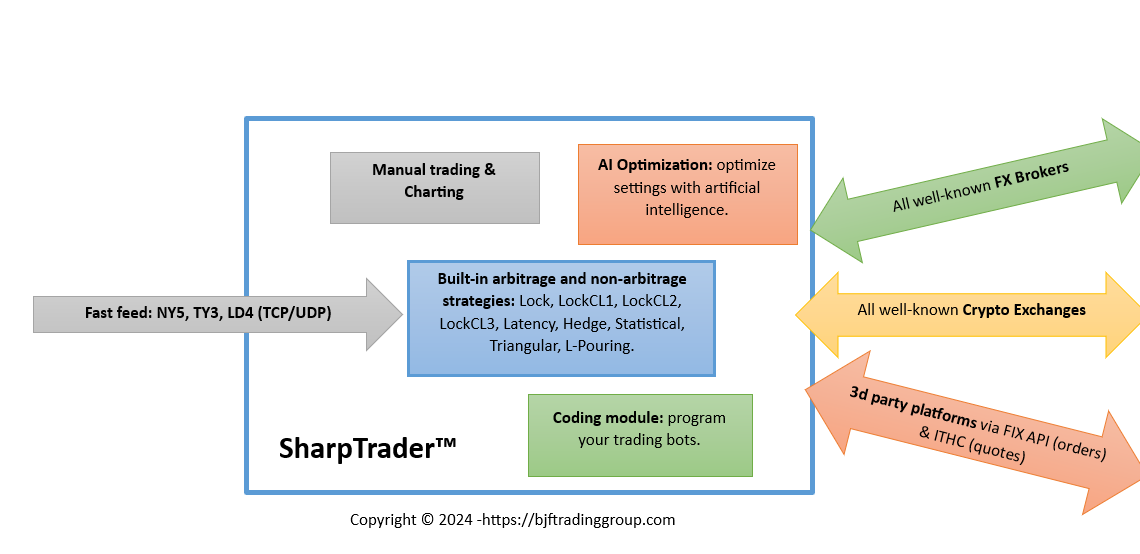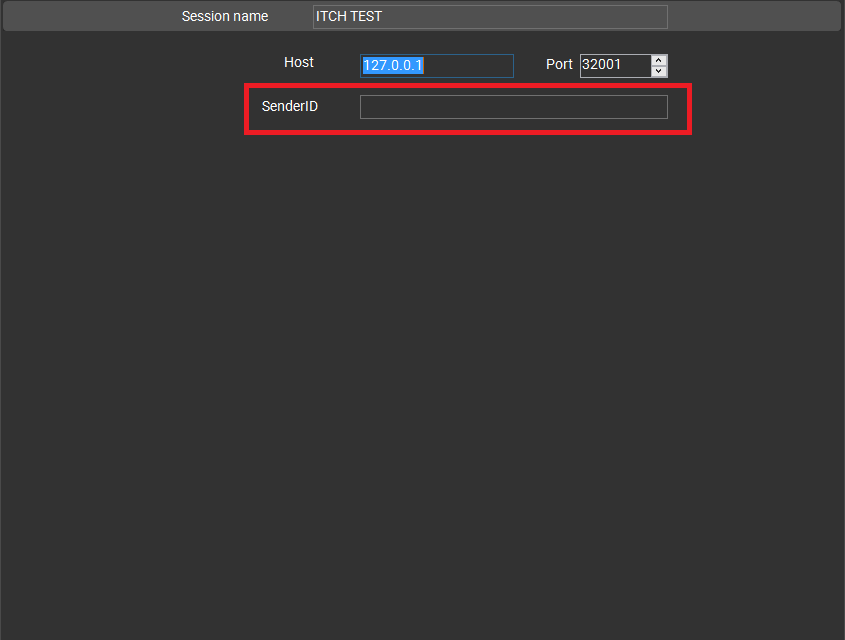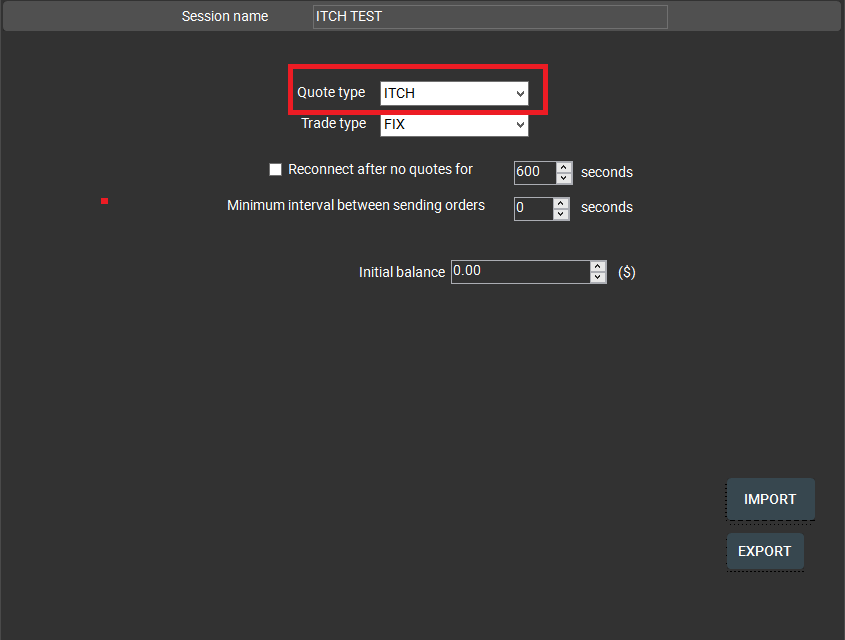Geschwindigkeit und Flexibilität im Duell: ITCH-Protokoll vs. FIX API bei der Übertragung von Finanzdaten Mittwoch, der 31. Januar 2024 – Posted in: Arbitrage Software, cryptoarbitrage software, Forex trading
Einleitung
Verschiedene Protokolle im Forex- (Devisen-) Markt ermöglichen eine effiziente, sichere und elektronische Kommunikation in Echtzeit zwischen den Marktteilnehmern. Diese Protokolle sind entscheidend für die Ausführung von Trades, die Übertragung von Marktdaten sowie die Verwaltung von Kundeninteraktionen. Nachfolgend finden Sie einen detaillierten Überblick über einige der wichtigsten Protokolle, die im Forex-Handel eingesetzt werden:
FIX-Protokoll (Financial Information eXchange)
- Zweck: FIX ist ein weit verbreitetes elektronisches Kommunikationsprotokoll für den internationalen Echtzeit-Austausch von Informationen im Zusammenhang mit den Finanzmärkten, insbesondere zur Ausführung von Trades.
- Funktionalität: Es ermöglicht die Übertragung von Finanzinformationen, einschließlich Handelsaufträgen, Ausführungsberichten, Marktdaten und anderen handelsbezogenen Nachrichten.
- Vorteile: Das FIX-Protokoll ist bekannt für seine Flexibilität, Zuverlässigkeit und breite Akzeptanz und gilt als Industriestandard für handelsbezogene Kommunikation.
APIs (Application Programming Interfaces)
- Zweck: APIs verbinden Handelsalgorithmen, Trading-Plattformen oder Anwendungen von Drittanbietern direkt mit dem Handelssystem eines Brokers.
- Typen: REST-APIs und WebSocket-APIs werden im Forex-Handel häufig eingesetzt. REST-APIs dienen zur Orderausführung, zum Zugriff auf Kontodaten und auf historische Marktdaten, während WebSocket-APIs für das Streaming von Marktdaten in Echtzeit verwendet werden.
- Vorteile: APIs ermöglichen individuelle Trading-Lösungen, algorithmischen Handel und Hochfrequenzhandel durch einen direkten und flexiblen Zugang zum Handelssystem des Brokers.
ITCH-Protokoll
- Zweck: ITCH wird hauptsächlich für die Übertragung von Marktdaten-Feeds verwendet und liefert Echtzeit-Marktinformationen wie Orderbuch-Updates und ausgeführte Trades.
- Funktionalität: Es stellt Händlern einen direkten Datenfeed von Börsen und anderen Handelsplätzen zur Verfügung und liefert Echtzeit-Updates.
- Vorteile: ITCH ist insbesondere im Hochfrequenzhandel aufgrund seiner Geschwindigkeit und Effizienz bei der Bereitstellung von Marktdaten von großem Wert.
Forex- (Devisen-) Marktprotokolle
- Zweck: STP ermöglicht die automatische Verarbeitung von Trades ohne manuelle Eingriffe – direkt von der Handelsplattform des Traders zur Ausführungsstelle des Brokers.
- Funktionalität: Es sorgt für eine nahtlose Orderausführung und reduziert Verzögerungen sowie Fehler bei der Handelsabwicklung.
- Vorteile: STP erhöht die Handelsgeschwindigkeit und Effizienz – ein entscheidender Faktor im schnelllebigen Forex-Markt.
SWIFT (Society for Worldwide Interbank Financial Telecommunication)
- Zweck: Obwohl es kein Handelsprotokoll im engeren Sinne ist, wird SWIFT für internationale Geldtransfers und die Abwicklung von Trades verwendet.
- Funktionalität: Es bietet ein Netzwerk, über das Finanzinstitute Informationen über Finanztransaktionen in einer sicheren, standardisierten und zuverlässigen Umgebung senden und empfangen können.
- Vorteile: SWIFT ist für die Abwicklung im Forex-Handel von zentraler Bedeutung und gewährleistet sichere sowie zuverlässige internationale Finanztransaktionen.
Diese Protokolle erfüllen spezifische Funktionen innerhalb des Forex-Handelsökosystems – von der Trade-Ausführung über die Datenübertragung bis hin zur Abwicklung. Die Wahl des Protokolls hängt häufig von den Anforderungen der jeweiligen Handelsaktivität ab, etwa von Geschwindigkeit, Flexibilität, der Art des Handels (manuell vs. algorithmisch) sowie vom Zugang zu Marktdaten und Ausführungsplätzen.
FIX-Protokoll – detaillierte Erklärung
Das Financial Information eXchange (FIX)-Protokoll ist ein weit verbreitetes elektronisches Kommunikationsprotokoll für den internationalen Echtzeit-Austausch von Informationen im Zusammenhang mit Wertpapiertransaktionen und Finanzmärkten. Nachfolgend finden Sie eine detaillierte Beschreibung des Datenübertragungsprozesses im FIX-Protokoll:
Verbindungsaufbau
Der erste Schritt bei der Datenübertragung über das FIX-Protokoll besteht im Aufbau einer Netzwerkverbindung zwischen zwei Parteien, in der Regel einem Client (z. B. Investor oder Trader) und einem Server (z. B. Broker oder Börse).
Der Client initiiert diese Verbindung üblicherweise durch das Senden einer Logon-Nachricht an den Server. Diese enthält Angaben wie die verwendete FIX-Protokollversion, eine eindeutige Sender-ID, eine Ziel-ID sowie weitere für den Sitzungsaufbau erforderliche Parameter.
Sitzungsverwaltung
Nach erfolgreichem Verbindungsaufbau beginnt die Sitzungsverwaltung. Dazu gehört der Austausch von Heartbeats (einfachen Nachrichten, die in regelmäßigen Abständen gesendet werden), um sicherzustellen, dass die Verbindung aktiv bleibt und der Status der Verbindung überwacht wird.
Das FIX-Protokoll fungiert als Sitzungsschicht und stellt einen zuverlässigen, geordneten und sicheren Nachrichtenaustausch sicher. Es verwaltet Sequenznummern, um die korrekte Reihenfolge der Nachrichten zu gewährleisten, und erkennt Lücken in der Nachrichtenfolge.
Nachrichtenformatierung
Das FIX-Protokoll kommuniziert über standardisierte Nachrichten. Jede Nachricht besteht aus einer Abfolge getaggter Datenelemente, die jeweils eine spezifische Information repräsentieren (z. B. Preis, Menge usw.).
Die Nachrichten folgen einem festen Aufbau: einem Standard-Header (mit Angaben wie Nachrichtentyp, Absender und Empfänger), dem Nachrichtenkörper mit Transaktionsdetails sowie einem Standard-Trailer, der Sicherheits- und Integritätsprüfungen wie eine Prüfsumme enthält.
Nachrichtentypen
Das FIX-Protokoll definiert zahlreiche Nachrichtentypen zur Abdeckung verschiedener Handelsprozesse, darunter Orderübermittlungen, Änderungen, Stornierungen, Statusabfragen, Ausführungsberichte und Marktdatenanfragen.
Jeder Nachrichtentyp besitzt ein spezifisches Format und relevante Felder. Eine Orderübermittlungsnachricht enthält beispielsweise Angaben zu Ordertyp, Menge, Preis und Finanzinstrument.
Datenübertragung und -verarbeitung
Nach der Formatierung wird die Nachricht über das Netzwerk vom Sender an den Empfänger übertragen.
Nach dem Empfang verarbeitet die FIX-Engine des Empfängers die Nachricht, indem sie diese parst, validiert und anschließend die entsprechende Aktion ausführt (z. B. Ausführung eines Trades oder Aktualisierung des Orderstatus).
Sitzungsbeendigung
Am Ende der Handelssitzung oder wenn die Verbindung nicht mehr benötigt wird, wird die Sitzung durch eine Logout-Nachricht beendet.
Der Logout-Prozess umfasst den Austausch von Logout-Nachrichten zwischen Client und Server, gefolgt vom Schließen der Netzwerkverbindung.
Während des gesamten Prozesses gewährleistet das FIX-Protokoll Sicherheit, Zuverlässigkeit und Integrität der Datenübertragung. Seine Robustheit und Anpassungsfähigkeit machen es zu einem Grundpfeiler moderner elektronischer Handelssysteme.
ITCH-Protokoll – detaillierte Erklärung
Das ITCH-Protokoll wird hauptsächlich zur Übertragung von Marktdaten in elektronischen Handelssystemen verwendet. Es handelt sich um ein Hochgeschwindigkeits-Datenfeed-Protokoll, das entwickelt wurde, um Marktinformationen in Echtzeit bereitzustellen.
Verbindungsaufbau
Das ITCH-Protokoll arbeitet typischerweise über eine Netzwerkverbindung – häufig über ein Hochgeschwindigkeits-Multicast-Netzwerk –, bei dem Daten von einer Quelle (meist einer Börse) an viele Empfänger übertragen werden.
Trader oder Unternehmen abonnieren die jeweilige Multicast-Gruppe, um Marktdatenfeeds zu empfangen.
Nachrichtenbasierte Kommunikation
Die Kommunikation erfolgt über einen kontinuierlichen Nachrichtenstrom. Jede Nachricht stellt ein eigenständiges Datenpaket dar, das ein bestimmtes Marktereignis beschreibt.
Diese Nachrichten decken Ereignisse wie Orderplatzierungen, Löschungen, Änderungen, Trades und Cross-Trades ab.
Datenformat und Struktur
ITCH-Nachrichten sind binär codiert, um minimale Größe und maximale Geschwindigkeit zu gewährleisten – entscheidend für Hochfrequenzhandel.
Jede Nachricht beginnt mit einem Header (z. B. Länge und Typ), gefolgt vom Nachrichtenkörper mit Details wie Symbol, Preis und Menge.
Echtzeitübertragung
Marktereignisse werden unmittelbar als ITCH-Nachrichten an alle Abonnenten gesendet und während des gesamten Handelstages kontinuierlich übertragen.
Verarbeitung von ITCH-Nachrichten
Empfangende Handelssysteme erfassen den Datenstrom, parsen die Nachrichten und aktualisieren die Marktsicht in Echtzeit. Aufgrund der Geschwindigkeit ist eine hochoptimierte Verarbeitung erforderlich.
Sequenzierung und Zuverlässigkeit
ITCH-Nachrichten sind sequenziell nummeriert, um Datenverluste zu erkennen. Mechanismen wie Re-Transmissions oder Backup-Feeds ermöglichen die Wiederherstellung verlorener Daten.
Sitzungsende
Am Ende des Handelstages wird eine Abschlussnachricht gesendet, die das Ende der Datenübertragung signalisiert.
Das ITCH-Protokoll ist auf maximale Geschwindigkeit, Effizienz und Zuverlässigkeit ausgelegt – insbesondere für Hochfrequenzhandelsstrategien.
ITCH-Protokoll vs. FIX-API-Protokoll
ITCH- und FIX-Protokolle werden in Finanzmärkten zur Kommunikation zwischen Clients und Servern eingesetzt, erfüllen jedoch unterschiedliche Aufgaben.
ITCH-Protokoll
- Zweck: Übertragung von Marktdaten in Echtzeit direkt von Börsen.
- Datenart: Fokus auf Orderbuchzustände, Trades und Marktaktivitäten.
- Geschwindigkeit: Optimiert für niedrige Latenz – ideal für Hochfrequenzhandel.
Protokollstruktur: Einseitiger Datenstrom mit leichtgewichtigem Nachrichtenformat.
FIX-Protokoll
- Zweck: Austausch handelsbezogener Nachrichten wie Orders, Ausführungen und Statusmeldungen.
- Datenart: Vielseitig – umfasst Orders, Reports und Marktdatenanfragen.
- Flexibilität: Hohe Anpassungsfähigkeit für verschiedene Assetklassen.
- Protokollstruktur: Bidirektional mit komplexer Nachrichtenstruktur.
Zusammengefasst ist ITCH ideal für ultraschnelle Marktdatenübertragung, während FIX ein universelles Protokoll für Handelskommunikation darstellt.
Erhöhte Datenübertragungsgeschwindigkeit mit SharpTrader: Einführung der ITCH-Protokoll-Integration
Wir freuen uns, eine bedeutende Erweiterung der SharpTrader-Arbitrageplattform bekannt zu geben. Ziel ist es, die Datenübertragungsgeschwindigkeit – insbesondere für Arbitrage- und Hochfrequenzhandelsstrategien – deutlich zu erhöhen.

Abb. 1. – Umwandlung aller SharpTrader-Quote-Sessions von EasyFIX zu ITCH
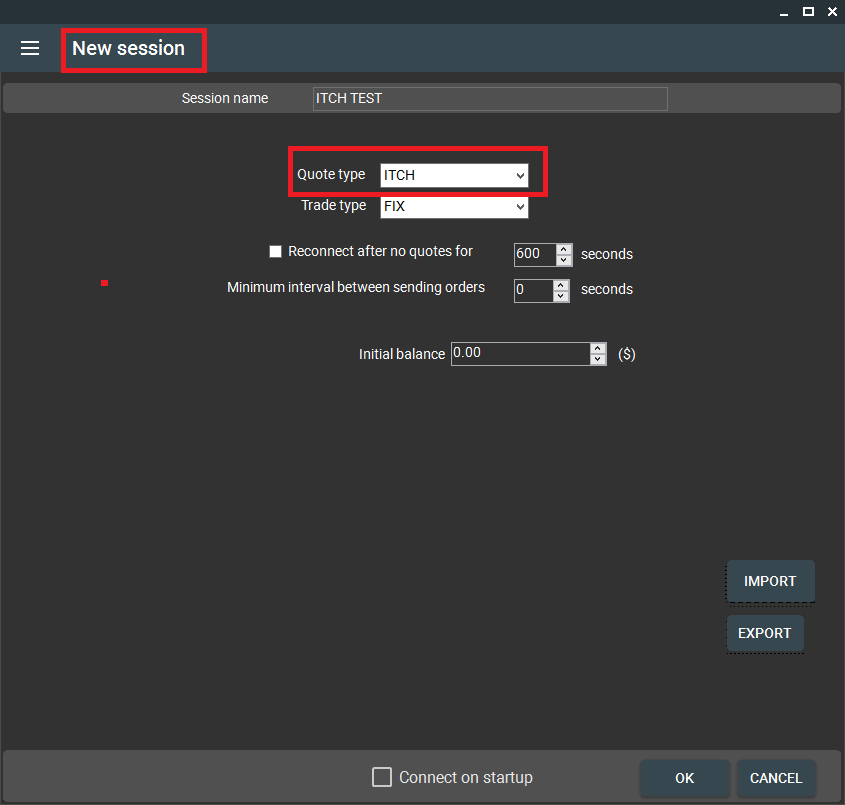
Abb. 2 – Erstellung einer neuen SharpTrader-Quotes-Session über das ITCH-Protokoll
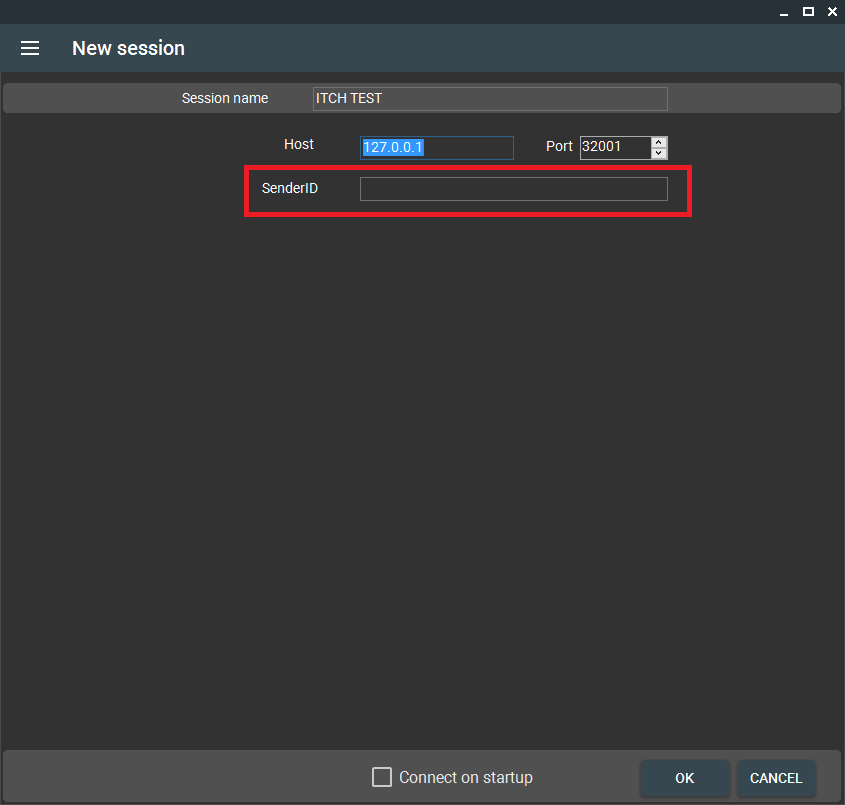
Abb. 3 – ITCH-Session Host:Port
Wir sind stolz darauf, die Integration des ITCH-Protokolls in die SharpTrader-Arbitrageplattform vorzustellen. Diese Innovation ermöglicht die gleichzeitige Nutzung von FIX-API und ITCH-Protokoll für Marktdatenübertragung.
Warum ist das wichtig? ITCH ist bekannt für seine extrem hohe Übertragungsgeschwindigkeit. Durch den Einsatz des ITCH-Protokolls kann SharpTrader eine deutlich schnellere Übertragung von Marktdaten bieten – entscheidend für Arbitrage- und Hochfrequenzhandelsstrategien, bei denen jede Millisekunde zählt.
Darüber hinaus reduziert diese Integration den Ressourcenverbrauch der Server erheblich, was zu einer stabileren und zuverlässigeren Handelsumgebung führt.
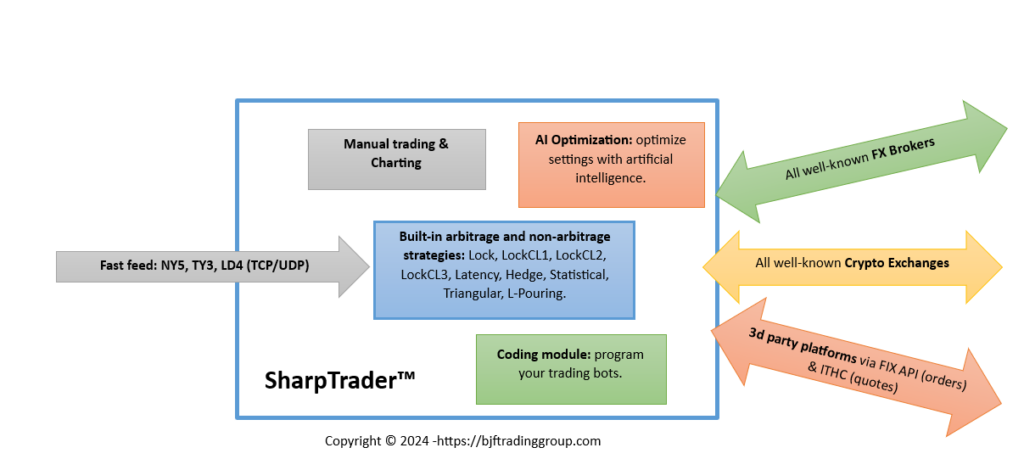
Zusammenfassend ist die Integration des ITCH-Protokolls in SharpTrader mehr als nur ein technisches Upgrade – sie ist eine strategische Erweiterung zur Optimierung Ihrer Handelsstrategien.
Vielen Dank, dass Sie uns als Ihren Handelspartner gewählt haben. Wir freuen uns darauf, Sie mit diesen erweiterten Möglichkeiten auf Ihrem weiteren Weg zum Erfolg zu begleiten.
 English
English 日本語
日本語 العربية
العربية 한국어
한국어 Español
Español Português
Português Indonesia
Indonesia Tiếng Việt
Tiếng Việt 中文
中文

